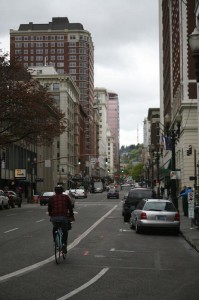Creative or Consumer Class? On inequality in urban growth
The media may thankfully be catching up with the dark economic underbelly of the mythos of urban prosperity, perhaps evidenced through a couple of articles based on a study by Jessie Handbury, an economist at Penn’s Wharton School. “[W]hen when high-skilled, high-wage professionals congregate in cities, some of their other expenses actually go down,” Atlantic Cities’ Emily Badger writ

es, “[while] it gets more expensive for low-income people to buy consumer goods like their groceries.” Is that the creative class at work building a better tomorrow? I suppose it’s not a major surprise, but it is nonetheless astounding that in these creative class meccas, there is such a substantial amount of poverty and wealthy disparity.
New York boasts a poverty rate of 21.2% alongside a median household income of somewhere just under $50,000. The city has a substantial income disparity even in wealthy and dense Manhattan, which in 2005 was $365,826 versus $7,047 between the highest and lowest quintiles of earners. San Francisco has about half the poverty rate and a household income about 130% that of New York. New York’s poverty rate is astonishing, but I suppose New York would argue that it is allowed to break rules as the Alpha and Omega of [fill in the blank: cities, America, the United States, Alpha Cities, The East Coast, Culture, Art]. Still, high poverty rates aside, NY and SF both can count as cities where, as Badger writes, “’median’ means a six-figure job and a taste for artisanal cheese.” I had a conversation with a friend who argued that the salaries of San Francisco’s approximately 9,000 city employees paid more than $100,000 were justified because the cost of living is so high. It doesn’t work like that. Or, it shouldn’t work like that in a state that is completely bankrupt.
When I graduated from college, Portland and Brooklyn were the places to be. (I think they still are, but correct me if I’m wrong, St. Louis.) I remember a conversation in the kitchen of my off-campus apartment with a suitor of one of my roommates. A boy from a mid-sized, decaying Midwestern town, I remember him saying in monotone, “Yeah, I’d really like to move out to Portland, Oregon after I graduate and working in tech,” before I completely zoned out. It’s true; it was, and is, the dream of many young people to go west, young man. Two hundred years later.
Having just returned from a trip to Portland last Monday, it’s a great town, and one can tell why young people flock there—one of the best craft brewing scenes in the nation, cheap street food alongside widely available cheap, fresh produce, and a deluge of restaurants, bars, and bus routes aplenty to boot. Not to mention the high density of paved area with bike lanes which makes it easy for biking. But I hear the same complaints about it that I hear about New York—a dearth of affordable housing. Portland boasts a ridiculously high occupancy rate (97% and, indeed, 100% in some specific areas), so it’s no surprise that the median rent is sky-high. And affordable housing in New York seems almost as mythical as an affordable drink in Chicago, or as common sense in St. Louis.
In the case of Portland, one thing I discovered is that, especially on the east side, many neighborhoods are a fairly low density. Portlanders are bent out of shape over a recent and ongoing spike in high-density buildings, many projects beginning in recent years to address the generally low-density city’s inundation by newcomers chasing the (dying) dream of the 90’s (and Midwesterners chasing some temperate weather). Their beef is that neighborhoods are being reconfigured to accommodate higher-density, and the city has boldly decreed that no parking shall be required for these massive structures which house, not surprisingly, automotively inclined residents.
While I am loath to ever suggest parking requirements for new construction (it drives up costs, is spatially inefficient, and is unnecessary in urban areas served by public transit), I understand the frustration of residents who have in effect been cut out of the deal. Heck, I drive my car hundreds of miles most weeks, and, while I don’t like it, it is necessary for my work (for now). You certainly don’t need a car in Portland, but I digress. Density and price: Density is shaped positively by increasing demand for space, and when demand increases disproportionately with the supply of space, the price—wait for it, the invisible hand’s coming- increases. New York has run out of space but its ego continues to metastasize, hence why Manhattanites bafflingly pay monthly in rent what I spend to buy ten intact houses in inner city Gary.
When we look to these cities as meccas of progressive thought and discourse, we’re forgetting that a classically liberal viewpoint would be to embrace a city for being not only a center of learning but also one embodying democratic and socioeconomically equitable values. New York City may be the great center of all, but it is run by a billionaire who continues to, in displays of power that walk the line between autocratic and laughable, exert his power to figure out new ways to force people to buy things differently. Truly bizarre. As we’ve allowed the trends to continue, the mad rush toward density in just a few places, often under the banner of advancing the “creative class” or promoting some glorified vision of young, progressive, creative folks jazzed about buzzwords, continues to actually result in a less democratic city.

